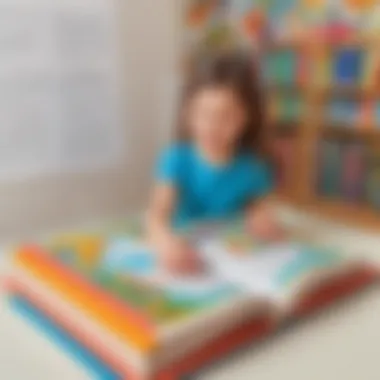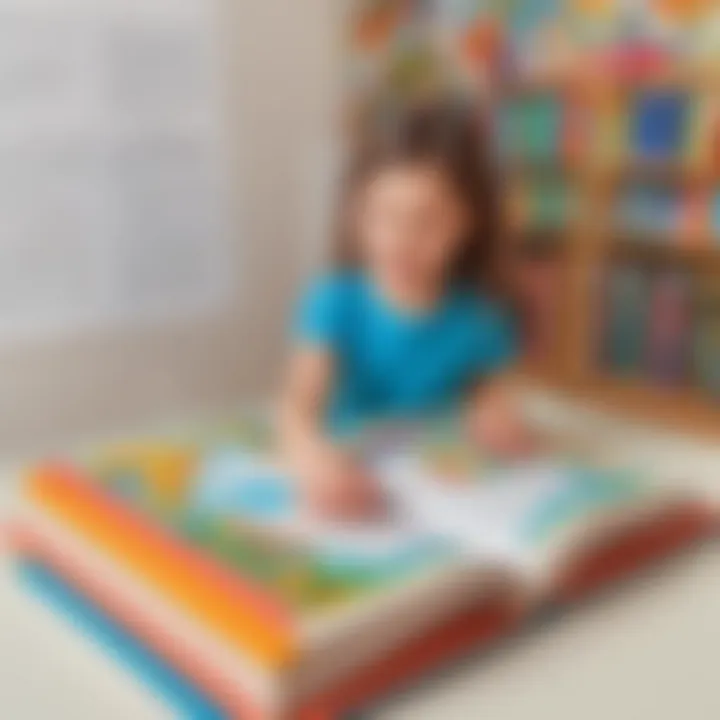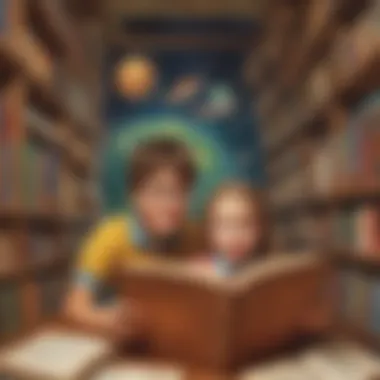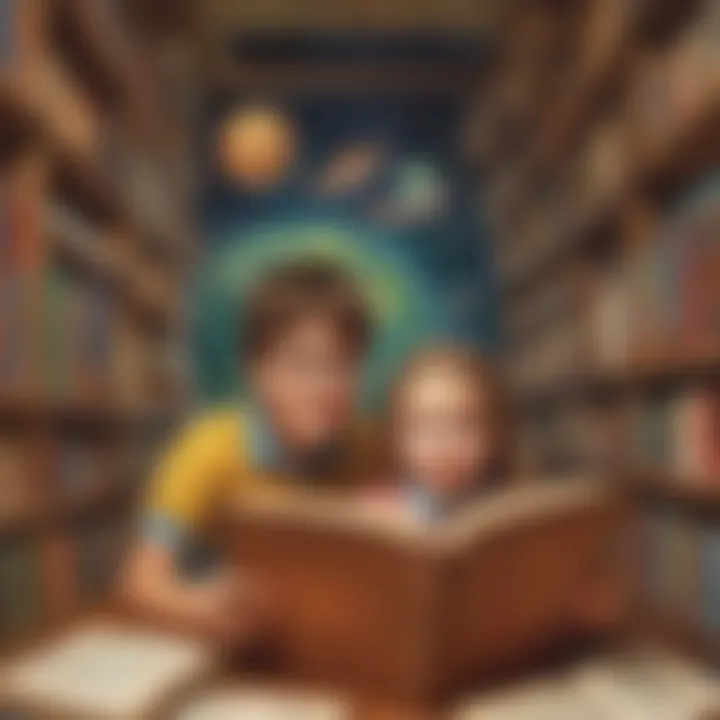Exploring a Diverse Collection of Engaging Books for Elementary School Children


Creative Activities
In this exciting section, we delve into the realm of creative activities designed to captivate and inspire the young, imaginative minds of elementary school children. Encouraging creativity at a tender age can foster critical thinking and problem-solving skills in our young learners. Let's explore some craft ideas that children can easily replicate, igniting their artistic talents and fostering a sense of accomplishment. Step-by-step guides will accompany each activity, providing detailed instructions to ensure seamless execution. Furthermore, we will discuss the educational value inherent in these creative endeavors, shedding light on how hands-on activities can enhance cognitive development and spark a love for learning.
Fun Quizzes
Engaging the curious minds of elementary school children, fun quizzes provide an interactive and stimulating way to reinforce learning outside the traditional classroom setting. Within this section, we will unveil a variety of quiz topics available on ElemFun, covering subjects spanning from science to literature. Exploring the different question types used in these quizzes, we aim to showcase how varied assessments can cater to different learning styles and preferences. Moreover, we will delve into the knowledge reinforcement aspect, illustrating how quizzes serve as effective tools to solidify the understanding of key concepts and foster a thirst for knowledge.
Fact-Based Articles
As we unravel the enchanting world of fact-based articles tailored for elementary school children, prepare to embark on a journey of discovery and enlightenment. Diving into an array of diverse topics, these articles offer engaging and easy-to-understand content, tailored specifically to cater to young readers. Through vivid storytelling and compelling narratives, intricate concepts are broken down into digestible pieces, making complex information more accessible. Additionally, supplementary resources such as related articles and external links will be provided, allowing readers to delve deeper into areas of interest and broaden their intellectual horizons. Get ready to unlock a treasure trove of knowledge and inspiration!
Introduction
Reading, especially for elementary school children, is more than a mere pastime; it is a gateway to a world of knowledge, imagination, and cognitive development. In this article, we delve into the intrinsic value of reading for young minds and explore the enriching experience it offers. By delving into the world of engaging books tailored specifically for this age group, we aim to ignite a passion for literature that goes beyond entertainment. Understanding the importance of cultivating a reading habit from a young age is paramount in nurturing a lifelong love for learning.
When we think about the significance of reading, it is essential to consider the multifaceted benefits it brings to children. From enhancing cognitive development to fostering language skills and nurturing creativity, the act of reading plays a pivotal role in shaping a child's overall growth and education. Through a careful selection of books that cater to elementary school children, we can immerse them in worlds that stimulate their minds and inspire curiosity.
One of the critical aspects of the Introduction is setting the stage for the subsequent discussions on various genres, interactive educational books, and encouraging creativity through reading. By laying this foundation, we provide a holistic view of how reading can be both engaging and educational for young readers. Emphasizing the importance of exploring different genres and incorporating reading into daily routines, we pave the way for a comprehensive understanding of the joy that books can bring to children.
In essence, this Introduction serves as a prologue to a journey through the enchanting realm of children's literature, aimed at promoting not just literacy but a genuine love for reading. By elucidating the benefits and considerations associated with introducing children to the world of books, we pave the way for an immersive exploration into the joy of reading for elementary school children.
Benefits of Reading for Children


Reading is a fundamental activity that plays a crucial role in the cognitive and emotional development of children. In this article, we explore the invaluable benefits that reading offers to young minds, focusing on cognitive development, language skills enhancement, and the stimulation of imagination and creativity. By nurturing a reading habit from an early age, children can experience a plethora of advantages that shape their intellectual growth and overall well-being.
Cognitive Development
Cognitive development is a key aspect of a child's growth, and reading plays a significant role in enhancing this process. When children engage with books, they are exposed to new ideas, concepts, and information that stimulate their thinking abilities. Reading helps improve critical thinking, problem-solving skills, and memory retention. Through the act of reading, children learn to analyze situations, make connections between events, and develop their cognitive faculties. It is through reading that children can expand their knowledge base and cultivate a curious and inquisitive mind.
Language Skills Enhancement
In the realm of language skills enhancement, reading reigns supreme as a potent tool for nurturing communication abilities. Exposing children to a variety of texts helps them develop vocabulary, grammar, and comprehension skills. By encountering different writing styles and genres, children learn to express themselves effectively, both in spoken and written forms. Reading also fosters a deeper understanding of language nuances, enhancing communication fluency and articulation. Moreover, through exposure to diverse linguistic structures, children broaden their horizons and become adept at conveying their thoughts and emotions with clarity.
Imagination and Creativity
Imagination and creativity are sparked and nurtured through the world of books. When children immerse themselves in stories and fantastical realms, they engage their creative faculties and broaden their imaginative capacity. Reading stories allows children to visualize scenes, characters, and plotlines, encouraging them to think beyond the ordinary and explore realms of fantasy. By fueling their imagination through reading, children develop innovative thinking, problem-solving skills, and the ability to think outside the box. Additionally, creativity flourishes as children create mental images and scenarios based on the narrative, fostering originality and ingenuity in their thought processes.
Exploring Different Genres
In the vast landscape of children's literature, the exploration of different genres serves as a vital component in nurturing young minds. Diving into various genres exposes children to a spectrum of storytelling techniques, themes, and characters, broadening their literary horizons. Through exposure to different genres, elementary school children can cultivate a deeper appreciation for diverse narrative styles, fostering both critical thinking skills and creativity. This article delves into the significance of exploring different genres within the context of elementary school reading, underscoring the immense value it brings to the intellectual and emotional development of young readers.
Fantasy
Fantasy literature, a realm where imagination knows no bounds, holds immense appeal for young readers embarking on their reading journeys. Within the fantastical worlds of magic, mythical creatures, and courageous heroes, children can escape the confines of reality and delve into realms of endless possibilities. By immersing themselves in fantastical narratives, children not only enhance their creativity but also develop empathy, as they connect with characters facing extraordinary challenges. Fantasy books for elementary school children often spark curiosity, encourage problem-solving skills, and instill a sense of wonder in young readers, making them a captivating avenue for literary exploration.
Adventure
The genre of adventure beckons young readers to embark on thrilling escapades, unfolding tales of courage, discovery, and resilience. Adventure books for elementary school children offer a blend of excitement and life lessons, as protagonists navigate through exhilarating challenges and unforeseen obstacles. Through these narratives, children are not only entertained but also inspired to embrace curiosity, confront fears, and embrace the unknown. The genre of adventure instills a sense of bravery and resourcefulness in young readers, shaping their outlook on challenges and instilling a spirit of exploration and perseverance.


Science Fiction
In the realm of science fiction, elementary school children delve into futuristic landscapes, scientific advancements, and thought-provoking dilemmas that push the boundaries of their imagination. Science fiction books transport young readers to worlds shaped by technology, space exploration, and speculative concepts, igniting a passion for innovation and discovery. Through science fiction narratives, children develop critical thinking skills, ponder ethical quandaries, and envision a world where the impossible becomes possible. Science fiction books for elementary school children serve as a gateway to exploring scientific principles in a creative and engaging manner, fostering a love for science and inquiry.
Interactive and Educational Books
In the realm of children's literature, the exploration of interactive and educational books stands as a pinnacle of enlightenment and engagement. Embracing these literary gems does not merely serve as a momentary pastime but as a conduit for cognitive growth and curiosity cultivation. Interactive books, with their vibrant illustrations and engaging activities, serve as gateways to a realm where learning interlaces seamlessly with entertainment. By involving the young readers actively in the content, these books ignite a flame of enthusiasm and eagerness to unravel the mysteries and knowledge hidden within their colorful pages.
Educationally, these books act as catalysts for enhancing core skills among elementary school children, from language proficiency to critical thinking abilities and problem-solving acumen. As they dive into interactive narratives, children are not just passive spectators but active participants, shaping the course of stories and engaging in stimulating exercises that foster their intellectual development. The blend of entertainment and education in these books creates a harmonious synergy that captivates young minds, laying the groundwork for a lifelong pursuit of learning and discovery.
Moreover, interactive and educational books cater to different learning styles, accommodating visual, auditory, and kinesthetic learners alike. Through interactive elements like puzzles, quizzes, and hands-on activities, these books cater to a spectrum of preferences and aptitudes, ensuring that every child finds a personalized avenue to delve into the enchanting world of literature and knowledge. By stimulating multiple senses and cognitive processes simultaneously, these books offer a holistic educational experience that transcends the traditional confines of rote learning, fostering a deeper understanding and retention of the content.
In selecting interactive and educational books for young readers, consideration should be given to the age-appropriateness, thematic relevance, and interactive features embedded within the content. The symbiosis of entertainment and education must be delicately balanced, ensuring that while the books remain engaging and fun, they also stimulate intellectual growth and curiosity. By integrating these captivating reads into a child's literary diet, parents and educators sow the seeds of a lifelong passion for reading and learning, nurturing inquisitive minds that will shape the future with wisdom and creativity.
Books That Encourage Creativity
In this segment, we delve into the realm of books specifically designed to ignite the flames of creativity in young minds. The significance of books that encourage creativity within the context of this article lies in their unparalleled ability to nurture a child's imagination and critical thinking skills within the framework of literature. By presenting young readers with stories and activities that prompt them to think outside the box, these books play a pivotal role in shaping a child's cognitive and emotional development.
Books that foster creativity serve as catalysts for inspiration and innovation, cultivating a mindset that embraces curiosity, originality, and problem-solving. Through engaging narratives, thought-provoking exercises, and interactive elements, these books not only entertain but also stimulate young readers to explore new ideas and perspectives. By encouraging children to visualize, create, and express themselves, these literary works lay the foundation for a lifelong appreciation of the arts and a thirst for knowledge.
An essential consideration when selecting books that promote creativity is their capacity to strike a balance between guidance and freedom. These books should offer structure to facilitate learning while allowing ample room for young imaginations to roam free. By providing a blend of directive prompts and open-ended tasks, these books empower children to unleash their creativity while honing their artistic skills, problem-solving abilities, and emotional intelligence.
Moreover, books tailored to enhance creativity in children not only entertain and educate but also instill valuable life skills such as resilience, adaptability, and self-expression. By immersing young readers in worlds where possibilities are endless and challenges are opportunities for growth, these books prepare them to navigate the complexities of reality with creativity and confidence. Ultimately, books that encourage creativity are not just sources of entertainment but indispensable tools for nurturing well-rounded individuals equipped to thrive in an ever-evolving society.
Incorporating Fun Reading into Daily Routine


In the bustling agendas of young ones, the act of incorporating fun reading into their daily routines emerges as a pivotal element in nurturing a lifelong affection for books. This article elucidates the significance of this topic, capturing the essence of weaving literary joy seamlessly into the fabric of a child's day. By infusing snippets of storytelling into their everyday schedule, youngsters not only cultivate their imagination but also enhance their cognitive skills. The blend of entertainment and education found in children's literature creates a harmonious juxtaposition that resonates well with the developmental needs of the youth, making it essential to carve out space for reading amidst the whirlwind of activities that encompass a child's day.
Creating a Reading Nook
Crafting a sanctuary dedicated to the pursuit of reading within the confines of a child's living space is a venture teeming with creativity and warmth. A reading nook serves as a haven where literary engagement flourishes, enveloping young readers in a cocoon of words and illustrations. By curating a cozy corner adorned with plump cushions, soft blankets, and shelves brimming with a diverse array of books, caregivers instill a sense of intimacy with literature in children. This intimate setting encourages uninterrupted exploration of stories, allowing young minds to wander freely through the realms of imagination that each book unveils.
Family Reading Time
Within the family unit lies the cornerstone of fostering a culture of reading. Time set aside for family reading sessions not only nurtures bonds between parents and children but also underscores the value of shared literary experiences. Engaging in the ritual of exchanging stories and reflections opens avenues for dialogue, planting seeds of curiosity and critical thinking in the minds of young ones. By amalgamating stories with the warmth of familial presence, caregivers lay a robust foundation for a child's holistic development, emphasizing not just the act of reading but the values and lessons that stories impart.
Rewarding Reading Habits
Incentivizing frequent and dedicated reading habits among children paves the way for a sustainable love affair with books. Rewards serve as tangible acknowledgments of a child's commitment to reading, motivating them to delve deeper into the vast expanse of literature available. By linking reading milestones to small incentives or tokens of appreciation, caregivers instill a sense of accomplishment and satisfaction in young readers. The practice of rewarding reading habits not only reinforces the positive behavior of engaging with books but also instills a sense of pride in children, fueling their eagerness to explore new narratives and genres.
Promoting a Love for Reading
In the realm of nurturing a lifelong passion for reading among elementary school children, the facet of promoting a love for reading emerges as a quintessential cog in the literary machinery. Why is promoting a love for reading deemed paramount? Primarily, instilling this ardor for books from a tender age not only cultivates a strong foundation for academic success but also nurtures traits such as empathy, critical thinking, and creativity. Parents and educators play pivotal roles in fostering this affection for books, creating an enriching environment where reading is not just a task but a cherished pastime.
To delve deeper into the significance of promoting a love for reading, it is imperative to acknowledge the multifaceted benefits it engenders. Encouraging a child's love for reading opens the doorway to vast realms of knowledge, stimulates cognitive growth, and enhances language proficiency. Furthermore, embracing books cultivates a fertile imagination and nurtures empathy by allowing young readers to walk in the shoes of diverse characters, fostering a deep understanding of different perspectives.
As we navigate the pivotal role of promoting a love for reading, considerations arise about the methodologies and strategies that can be employed to ignite this passion. Implementing a varied and age-appropriate reading list tailored to a child's interests is fundamental. Moreover, creating engaging reading spaces, such as cozy nooks or designated reading corners at home or in schools, can enhance the reading experience. Family involvement through shared reading sessions and discussions also plays a substantial role in nurturing a love for books. Additionally, rewarding reading milestones and achievements can instill a sense of accomplishment and motivation, further fueling the enthusiasm for reading.
In essence, the promotion of a love for reading lays the groundwork for a lifelong relationship with books, shaping not only academic success but also fostering qualities that transcend the realms of education. By incorporating thoughtful strategies and fostering a nurturing environment rich in literary stimuli, caregivers and educators can kindle a robust enthusiasm for reading in young minds, paving the way for a future generation of avid readers and lifelong learners.
Conclusion:
The conclusion serves as a compass, guiding both parents and educators in nurturing a voracious appetite for books among the impressionable youth. It underscores the pivotal role that engaging and educational literature plays in shaping not just cognitive abilities but also emotional intelligence and empathy in children. Through the power of storytelling and imagination, young readers are transported to fantastical worlds, broadening their horizons and enriching their perspectives.
Delving deeper, the conclusion encapsulates the idea that reading is not merely a pastime but a transformative experience. It cultivates critical thinking skills, enhances language proficiency, and fuels creativity in ways that traditional forms of education often fall short. By weaving together threads of curiosity, joy, and intellectual stimulation, the conclusion reaffirms that books are not just companions but gateways to infinite possibilities.
In essence, the conclusion serves as a poignant reminder of the profound impact that a well-chosen book can have on a child's holistic development. It elucidates the synergy between entertainment and education, elucidating how tales of whimsy and wonder can sow the seeds of knowledge and enlightenment. Ultimately, in the tapestry of a child's growth, the conclusion stands as a testament to the enduring allure and transformative power of literature, beckoning young hearts and minds to embark on a lifelong journey of discovery and delight.







